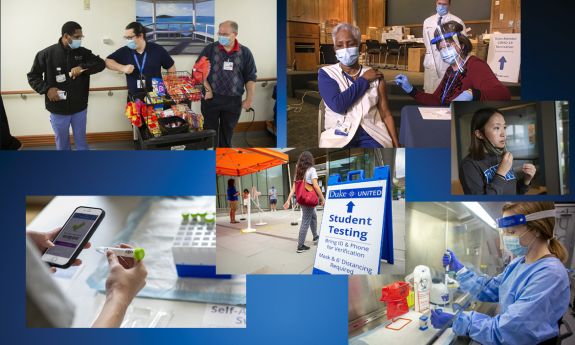Nearly 1 Million Tests Mark End to Part of Duke’s COVID-19 Response
Surveillance testing, as well as other aspects of COVID-19 response, come to an end

Formal student COVID case management ended on March 19. The SymMon App, which allowed Duke students, staff and faculty to record and report COVID-19 symptoms, will be retired on April 3. Employees can use the My COVID Link to report symptoms or test results, and students should contact Student Health to do the same. While still required in all patient care and clinical settings and for anyone who is symptomatic, masking is no longer required on buses or while riding in vans, though it is recommended.

These moves are possible because reported COVID-19 cases, hospitalizations and ER visits have dropped to their lowest rates in Durham and across the state. During the past 18 months, the Duke population has developed substantial immunity through vaccination or natural infection
“This is a very good sign of how far we’ve traveled with this pandemic,” said Dr. Carol Epling, executive director of Duke Employee Occupational Health & Wellness. “It shows how much collaborating teams of devoted people have accomplished.”
Duke’s medical experts are currently assessing potential changes in the COVID vaccination policy given the increase in population immunity and decline in severity of illness.
While most of the COVID-19 safety precautions have been eased in non-clinical or non-patient care environments, there are still some steps to be taken to protect yourself and those around you.
If you display COVID-19 symptoms, it’s important to get tested and, if you test positive, isolate. Symptomatic testing is still available on campus through Student Health or the Employee Exposure Hotline which can be reached at 919-385-0431, option 1. At-home rapid antigen tests are available at the Duke University Stores service desk in the Bryan Center to anyone with a valid DukeID with a limit of one test per week.
Even if you test negative, Epling recommends wearing a mask until your symptoms subside in order to halt the spread of other respiratory diseases.
And as the virus evolves, it remains vital to stay up to date on vaccine boosters as they are released.

“We are in a profoundly better place than we have been at any point in the past, locally, nationally and globally,” said Associate Professor of Medicine Dr. Cameron Wolfe, an infectious disease expert. “We see significantly diminishing rates of morbidity and mortality. Although, it’s still here, and I think it would be wrong to fall into the trap of assuming it’s gone, though its ability to impact us on a day-to-day or week-to-week nature has passed.”
Since the summer of 2020, the finite COVID-19 testing resources at Duke were devoted to community members who were displaying symptoms. But in order to resume on-site instruction that fall, the university was going to need a way to test large numbers of asymptomatic Duke community members in order to track the virus as it moved through campus and quarantine those infected.
For help, Duke turned to the Duke Human Vaccine Institute (DHVI), which, through its HIV research, had experience testing large numbers of samples for disease.
Duke’s surveillance testing plan, which went into effect in August of 2020, involved in-person students, staff and faculty to be tested roughly twice per week and have the samples processed by DHVI using a pooled testing method. The method features batches of multiple combined samples tested together. If the batch produces a positive result, each individual sample will be retested to see which one contains the virus. The approach allowed Duke to process a high volume of tests without straining testing resources.

“I think it kept us open, frankly, for the whole first year,” Wolfe said. “It was an investment. It was a lot of effort. It was a lot of cost. But what it did was it gave us a far greater visibility on the way an infection could move and gave us a better sense of the dynamics of the spread through dormitories, classrooms, sports field and the community.”
DHVI added team members and lab space to process the tests in facilities in Genome Sciences Research Building II, the Sands Building and Medical Sciences Research Building I devoted to the surveillance testing program. Teams worked in three shifts per day, six days per week processing the tests. At its peak, the operation, which in the fall of 2021 moved to DHVI’s facilities in Research Triangle Park, handled roughly 30,000 tests per week.
The program allowed Duke’s students to be tested roughly twice per week and be notified of a positive result within 24 hours. By the time it ceased operations, the surveillance testing program had conducted 986,303 tests.
“We developed some incredible partnerships and collaborations,” Denny said. “We were working together to overcome something and help Duke stay open, stay productive and do the things that Duke is here to do.”
Send story ideas, shout-outs and photographs through our story idea form or write working@duke.edu.